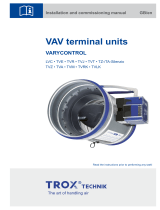
VLT
®
6000 HVAC
4
MN.60.A1.02 - VLT is a registered Danfoss trademark
■■
■■
■ Sensor Type And Placement
The energy savings capabilities of a properly instal-
led VLT frequency converter system is well known.
However, the importance the sensor type and
placement has on these calculations is often
overlooked. To achieve the expected energy savings,
it is critical that the sensors are placed properly in the
system.
For VAV systems, a pressure sensor should be
placed roughly 2/3 of the distance of the supply
ductwork downstream of the supply fan. Placing
the sensor downstream of the fan allows us to take
advantage of the reduced resistance the ducts have
at lower flow rates and allows us to maintain a lower
setpoint value (see fig. 7b).
The goal of the fan system is to maintain the mini-
mum required static pressure at the inlet of the VAV
boxes. This allows the VAV boxes to operate properly
and evenly distribute the air to the controlled zone.
The fans discharge pressure requirement is calcu-
lated by adding the static pressure that is required
for proper operation of the VAV boxes to the
pressure drop expected in the ductwork. Then a
safety margin is applied to compensate for any
unforeseen design modifications required during
installation.
When the static pressure sensor is placed directly
after the discharge of the supply fan. Any oversizing
of the fan can be eliminated and balancing of the
system is simplified. However, in order to guarantee
proper operation of the VAV boxes, the pressure
drop in the duct during maximum flow conditions
must be assumed requiring the pressure setpoint to
be set equal to the design pressure of the fan (fig.
7a). The area between the control curve and the
system curve represents the wasted energy. As air
flow is reduced, the fan continues to produce this
high pressure even though the pressure losses in the
ducts have been greatly reduced. This results in more
pressure being supplied to the VAV boxes than is
necessary for proper operation. Some energy is
saved with this technique, but the full energy saving
potential is not realized. The over pressurization
which occurs at low flow is the cause of the wasted
energy.
When the static pressure sensor is placed roughly 2/3
downstream the system automatic compensation for
the actual pressure drop in the duct occurs. As a
result, the fan only produces the pressure that is
required by the VAV boxes, regardless of the flow.
This sensor placement optimizes energy savings.
Figure 7 shows the impact the sensor placement can
have on energy savings. The lower the minimum
setpoint, the slower the VLT frequency converter can
run the fan saving increasing amounts of energy.
Pressure
transmitter
Supply fan
VAV boxes
Area of energy saved
Pressure
transmitter
Supply fan
VAV boxes
Area of energy saved
Fig. 7
10%
100%
Energy consumption with 100% setpoint
Total energy consumption per year: 185581 kWh
Annual savings: (49056 x USS 0.10) USS 4906
Energy consumption with 10% setpoint
Total energy consumption per year: 91013 kWh
Annual savings: (143624 x USS 0.10) USS 14362
a)
b)




